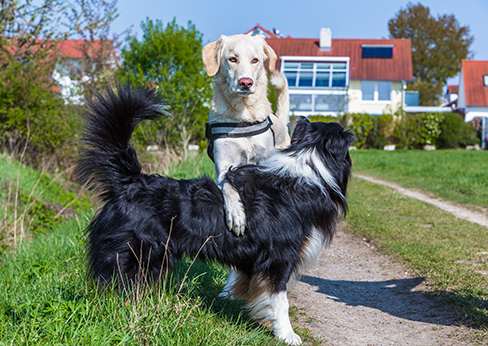In this post:
- What Is Dominance?
- What role does dominance play in our dogs? Do they need to be the alpha dog/pack leader?
- Do dogs feel the need to exert themselves as the alpha dog over people?
- Are there breeds of dogs that are more dominant than others? Are “bully” breeds considered very dominant?
- Should a person try to “dominate” their dog? Is it good practice to try to be the alpha dog or pack leader over your dog?
- If dominance is not the issue, then what would you say is the number one problem with dogs who have behavioral issues?
We’re all familiar with phrases like “alpha dog” or “top dog,” but what do they really mean? It’s assumed this terminology comes from nature and is often used to describe people and animals who behave dominantly.
Many dog owners believe that their dogs respect a display of dominance, so they have to behave in a physically aggressive way towards them. But is this necessarily true? In this article, we asked the renowned animal behavioral expert, Dr. James C. Ha, Ph.D., CAAB, some common questions about dominance in the dog-owner relationship.
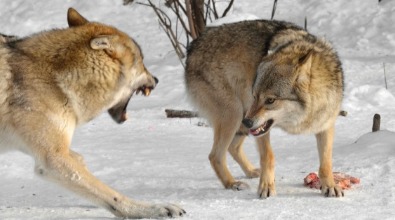
What Is Dominance?
The number one thing to understand about dominance is that dominance happens because there are limited resources, and only when those resources become scarce. It is merely a form of aggression and social structure that decides who gets access to the resources first, gets access to the resources second, and who gets access to the resources last.
It is very much tied to the amount of food available in the wild. It is also a mechanism to settle disputes within the pack in a non-destructive, non-fighting way.
What role does dominance play in our dogs? Do they need to be the alpha dog/pack leader?
Dominance does apply to domesticated dogs because virtually all species of animals have to have some way to manage limited resources. The first thing to remember is that dominance is only going to happen when there are scarce resources. And with domestic dogs, our pets, there are very rarely limited resources. They have plenty of food; they have plenty of attention; they have plenty of everything that they need. So it is not necessary for dominance.
Do dogs feel the need to exert themselves as the alpha dog over people?
There are a few breeds of dogs that still have a solid sense of social structure. On infrequent occasions, if there are limited resources, some members of these breeds may form social structures. They will try to assert dominance in situations where they feel valuable resources, like human attention, are scarce. And in these rare cases, the dogs will act out against other dogs, or members of their social pact.
But a dog acting out in a show of dominance against a human is very rare. Rare enough that it has only been witnessed in clinical trials.
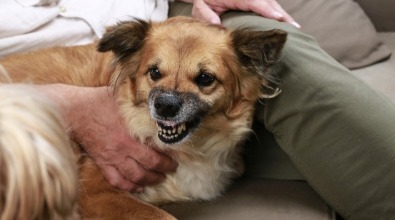
Are there breeds of dogs that are more dominant than others? Are “bully” breeds considered very dominant?
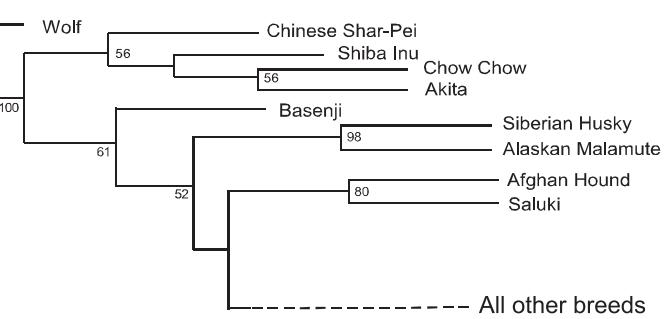
There is one type of dog breed that has been described by the geneticists as “ancient breeds.” Dogs that are members of this breed group are basically indistinguishable from wolves in their genetics. Because of this, they tend to be very wolf-like in their behavior. This means they can be more aggressive, are very powerful hunters, and tend to have much stronger dominance hierarchies. All of these things do add up to dominance issues. So when we see a dominance issue in a dog, either with other dogs or with their owner, it tends to be from this lineage of “ancient breeds.”
The need to exert dominance and social structure over limited resources is only found in a few breeds because most dogs have that behavior bred out completely. Dominance tends to be unimportant in all of the terriers, which is where the pit bulls and a lot of the bully breeds come from. Another group another clearly genetically defined are the mastiffs, and again it is virtually unknown to have dominance behavior issues in those groups.
Should a person try to “dominate” their dog? Is it good practice to try to be the alpha dog or pack leader over your dog?
Hovering over your dog or rolling them onto their back (also known as the “alpha roll”) is never a good idea. This is not the way dogs communicate hierarchy. Wild dogs and wolves do not display these behaviors.
Since dogs of any breed do not recognize this to be a sign of dominance, it is even more likely to be simply interpreted as an attack by a human.
And that results in a variety of other issues and problems, all of which damage the relationship.
If your dog and another dog get into an altercation, do not hover of them, interfere with their actions, or roll your dog over on their back. Your dog will not see this as an expression of dominance toward the other dog; they will see it as you attacking them and react accordingly.
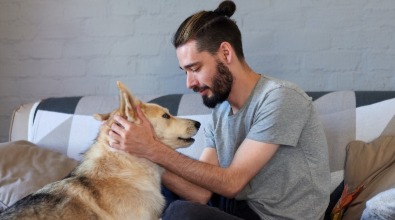
If dominance is not the issue, then what would you say is the number one problem with dogs who have behavioral issues?
Probably 80% of the cases of aggression that I see has to do with anxiety. Anxiety is the major aggression problem in dogs and the one that we have to work on the most to fix. Anxiety is the driver that causes almost all aggression in dogs. We need to research it more thoroughly, and we need to find solutions for it.
Pet owners need to do a better job of recognizing it in their pets and calming them down before things escalate.
I wish every dog owner had a better understanding of anxiety was able to see and understand anxiety in their dog. What every pet owner needs to do is recognize when their dog is anxious and learn how to deal with that first.
Special Thanks To …

Dr. James C. Ha, Ph.D., CAAB
Dr. James C. Ha, Ph.D., CAAB is a professor of applied animal behavior at the University of WA and a certified applied animal behaviorist with over 30 years of experience in animal behavior teaching, research, consulting, and expert witness services. Aly was privileged enough to be in his Applied Animal Behavior Certification program.
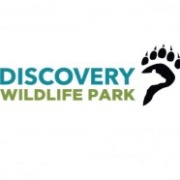
Discovery Wildlife Park
Discovery Wildlife Park is a refuge for orphaned and unwanted wildlife. They provide “forever” homes for animals who are not able to be returned to the wild. It is located on a 90-acre park with over 30 species of orphaned animals. They offer many family fun adventures from visiting the animals in their zoo to camping.





